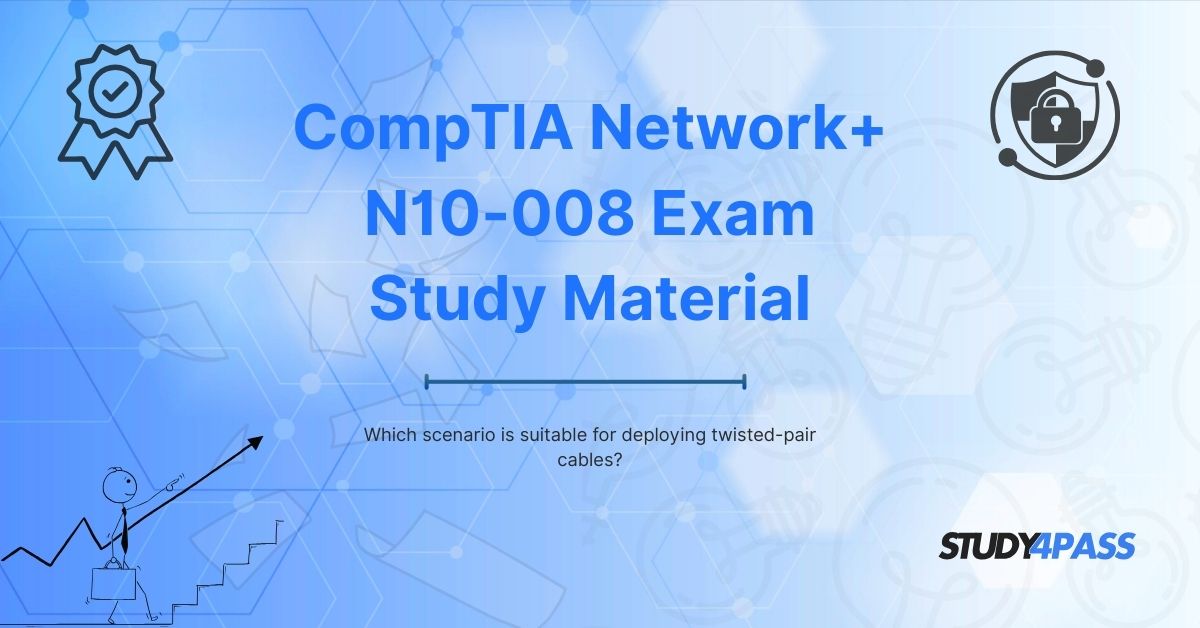Introduction
Twisted-pair cables are one of the most commonly used networking cables in modern communication systems. They are widely deployed due to their cost-effectiveness, flexibility, and reliability in various networking environments. For the CompTIA Network+ (N10-008) exam, understanding the appropriate scenarios for deploying twisted-pair cables is essential.
In this article, we will explore:
- What twisted-pair cables are
- Different types of twisted-pair cables
- Two key scenarios where twisted-pair cables are suitable
- Advantages and limitations of twisted-pair cables
- How Study4Pass can help you prepare for the CompTIA Network+ certification
By the end of this guide, you will have a clear understanding of where and why twisted-pair cables are used, helping you succeed in your CompTIA Network+ certification exam.
What Are Twisted-Pair Cables?
Twisted-pair cables consist of two insulated copper wires twisted together to reduce electromagnetic interference (EMI) and crosstalk. They are categorized into two main types:
- Unshielded Twisted Pair (UTP) – Most commonly used in Ethernet networks; lacks additional shielding.
- Shielded Twisted Pair (STP) – Contains an extra foil or braided shielding to further reduce interference.
These cables are classified into different categories (Cat5e, Cat6, Cat6a, Cat7, etc.), each supporting varying bandwidths and speeds.
Two Suitable Scenarios for Deploying Twisted-Pair Cables
1. Ethernet Networks (LAN Deployments)
Twisted-pair cables, especially Cat5e, Cat6, and Cat6a, are the backbone of Local Area Networks (LANs). They are ideal for:
- Office Networks – Connecting computers, printers, and switches.
- Home Networks – Providing internet connectivity via routers and modems.
- Data Centers – Used for short-distance, high-speed connections.
Why Twisted-Pair for LANs?
Cost-Effective – Cheaper than fiber optics.
Easy Installation – Flexible and lightweight.
Supports High Speeds – Cat6 supports up to 10 Gbps over short distances.
2. Telephone Systems (Voice Communications)
Twisted-pair cables have been traditionally used in telephone lines due to their ability to carry analog signals efficiently.
Why Twisted-Pair for Telephony?
- Reduced Crosstalk – Twisting minimizes interference.
- Reliable for Analog Signals – Suitable for voice transmissions.
- Backward Compatibility – Works with both old and modern phone systems.
When NOT to Use Twisted-Pair Cables?
While twisted-pair cables are versatile, they are not suitable for:
- Long-distance communications (Fiber optics are better).
- High-interference environments (Shielded cables or fiber may be needed).
- Extremely high-speed requirements (Fiber or higher-grade cables are preferred).
Advantages of Twisted-Pair Cables
- Affordable – Lower cost compared to fiber optics.
- Flexible & Easy to Install – Can be bent and routed easily.
- Widely Supported – Compatible with most networking devices.
Disadvantages of Twisted-Pair Cables
- Limited Distance – Signal degradation after 100 meters (without repeaters).
- Susceptible to EMI – Unshielded variants can suffer from interference.
How Study4Pass Helps You Prepare for CompTIA Network+ (N10-008)?
Preparing for the CompTIA Network+ certification requires a structured approach. Study4Pass offers:
- Comprehensive Study Guides – Covering all N10-008 exam objectives.
- Practice Tests – Simulating real exam scenarios.
- Expert Explanations – Detailed answers to reinforce learning.
- Up-to-Date Material – Aligned with the latest CompTIA standards.
By using Study4Pass, you can confidently master networking concepts, including cable types, topologies, and deployment scenarios, ensuring exam success.
Conclusion
Twisted-pair cables are best suited for:
- Ethernet Networks (LANs)
- Telephone Systems (Voice Communications)
Understanding these scenarios is crucial for the CompTIA Network+ (N10-008) exam. For the best preparation, leverage Study4Pass expert resources to enhance your knowledge and pass your certification with ease.
Special Discount: Offer Valid For Limited Time “N10-008 Exam Prep Practice Test”
Actual Exam Questions For CompTIA's N10-008 Certification
Sample Questions For CompTIA N10-008 Exam Practice
1. In which environment is twisted-pair cabling most commonly deployed?
A) High-voltage power transmission
B) Local Area Networks (LANs)
C) Satellite communication systems
D) Submarine cable networks
2. Twisted-pair cables are ideal for which of the following scenarios?
A) Short-distance data transmission in office networks
B) Intercontinental data transfer
C) High-frequency microwave links
D) Underwater fiber optic communication
3. When selecting a cable for connecting computers in a corporate building, twisted-pair cables are preferred because:
A) They are water-resistant
B) They offer good performance over short distances at low cost
C) They require no insulation
D) They are immune to electromagnetic interference
4. Which scenario would be least suitable for twisted-pair cables?
A) Connecting devices in the same room
B) Long-distance backbone internet infrastructure
C) Office computer network wiring
D) Residential telephone wiring
5. Twisted-pair cables are best used in:
A) Large outdoor installations exposed to weather
B) Indoor environments with moderate EMI
C) Deep-sea communication links
D) Radio tower connections


